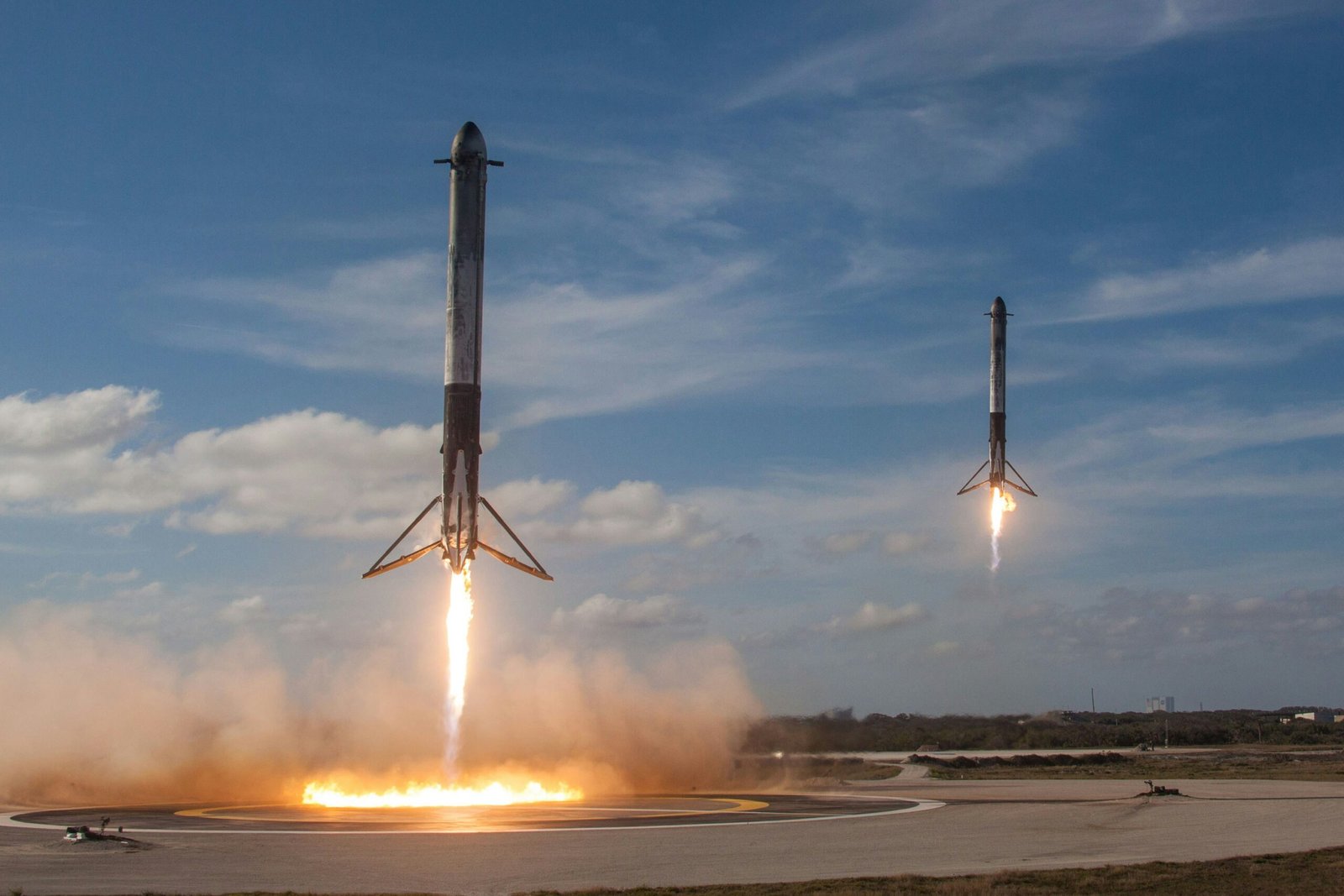SpaceX’s Starship Successfully Completes Orbital Test Flight
Introduction to SpaceX’s Starship Program
SpaceX’s Starship program represents a groundbreaking venture in the realm of space exploration. Embodying Elon Musk’s vision of interplanetary travel, the Starship aims to revolutionize our approach to space missions. The program’s primary objective is to develop a fully reusable spacecraft capable of carrying humans to Mars and beyond, thereby facilitating the establishment of a sustainable human presence on other planets.
The inception of the Starship program can be traced back to 2012, when SpaceX first unveiled its plans for the Mars Colonial Transporter. Over the years, the concept evolved, leading to the development of the Interplanetary Transport System (ITS) and, subsequently, the Starship. This spacecraft is designed to be fully reusable, reducing the cost of space travel and enabling more frequent missions. The Starship, standing at 120 meters tall when combined with its Super Heavy booster, is poised to be the most powerful rocket ever built, capable of carrying over 100 metric tons of payload to low Earth orbit.
Key milestones in the Starship program’s history include the successful hop tests of the Starhopper prototype in 2019 and the high-altitude flight tests of the Starship prototypes, SN5 and SN6, in 2020. These tests demonstrated the feasibility of the vehicle’s design and its ability to perform controlled landings. The program reached a significant milestone with the recent orbital test flight, showcasing the Starship’s capability to achieve orbit and return safely to Earth.
The significance of the Starship program extends beyond its technical achievements. By aiming to create a fully reusable spacecraft, SpaceX is setting new benchmarks in the aerospace industry. The program’s success could pave the way for more ambitious space missions, including crewed missions to Mars, lunar exploration, and deep-space travel. As we stand on the brink of a new era in space exploration, the Starship program epitomizes the innovative spirit and relentless pursuit of progress that define SpaceX’s contributions to humanity’s quest to explore the cosmos.
SpaceX’s development of the Starship has been a monumental engineering endeavor, marked by numerous technical challenges and groundbreaking innovations. One of the primary obstacles was selecting the appropriate materials to withstand the rigors of space travel and re-entry. Engineers opted for stainless steel, specifically the 301 alloy, which provides an optimal balance of strength, heat resistance, and cost-effectiveness. This choice was pivotal in addressing the structural integrity required for both launch and re-entry phases.
Another significant challenge was the design and implementation of effective heat shielding. The Starship’s thermal protection system had to endure extreme temperatures experienced during atmospheric re-entry. SpaceX engineers employed a combination of thermal tiles and ablative heat shields, drawing inspiration from previous space missions while incorporating modern advancements. This hybrid approach ensured that the spacecraft could safely return from orbit without compromising its structural components.
Propulsion systems also posed a considerable engineering hurdle. The Raptor engines, which power the Starship, are designed to operate on a mixture of liquid methane and liquid oxygen. This choice of propellant not only enhances efficiency but also aligns with SpaceX’s long-term vision of fueling missions using resources available on Mars. Developing the Raptor engines required extensive research and numerous iterations to achieve the necessary thrust and reliability for both terrestrial and extraterrestrial operations.
Throughout the development process, the SpaceX team faced and overcame numerous obstacles. Engineers and developers worked tirelessly to refine designs, conduct rigorous testing, and implement innovative solutions. For instance, structural integrity was a critical focus area, leading to the introduction of advanced welding techniques and materials testing to ensure the spacecraft could withstand the immense pressures of launch and space travel.
Insights from the SpaceX team reveal a culture of relentless innovation and iterative improvement. “Each challenge we encountered was an opportunity to innovate,” remarked one senior engineer. This mindset propelled the Starship project forward, transforming theoretical concepts into tangible, flight-ready technology. The successful completion of the orbital test flight stands as a testament to the ingenuity and perseverance of the SpaceX engineering team.
Pre-Launch Preparations
The success of SpaceX’s Starship orbital test flight was the result of meticulous pre-launch preparations, underscoring the company’s commitment to excellence in aerospace technology. The final assembly of the spacecraft was a pivotal phase, requiring precision and coordination. Engineers meticulously integrated the various components, ensuring structural integrity and functionality. This phase also involved the installation of advanced avionics systems, essential for navigation and communication during the flight.
Rigorous testing procedures followed the assembly. Each subsystem underwent exhaustive evaluations to verify performance under simulated conditions. These tests included thermal vacuum tests, structural load tests, and propulsion system verifications. The spacecraft’s reusability features, a hallmark of SpaceX’s innovation, were also scrutinized to ensure they met design specifications. The objective was to identify and rectify any potential issues that could jeopardize the mission.
Simulations played a critical role in the pre-launch preparations. Advanced computer models replicated the entire flight sequence, from liftoff to orbital insertion and reentry. These simulations allowed the SpaceX team to anticipate and address potential anomalies. Furthermore, they provided valuable data to refine flight algorithms and optimize mission parameters.
Safety protocols were paramount throughout the preparation process. SpaceX implemented comprehensive risk assessments and developed contingency plans for various scenarios. This included ensuring the safety of the launch site, personnel, and the surrounding environment. Collaboration with regulatory bodies, like the Federal Aviation Administration (FAA), was essential to secure the necessary approvals and ensure compliance with safety standards.
The collaborative efforts of the SpaceX team were instrumental in achieving readiness for the orbital test flight. Engineers, scientists, and support staff worked in unison, demonstrating exceptional teamwork and dedication. Additionally, SpaceX partnered with other organizations, such as NASA, to leverage expertise and resources. These partnerships not only enhanced the technical capabilities of the mission but also fostered a spirit of innovation and exploration.
The Orbital Test Flight: A Step-by-Step Breakdown
SpaceX’s Starship orbital test flight marks a significant milestone in space exploration, showcasing the advanced capabilities of the spacecraft. The mission commenced with a flawless liftoff from the SpaceX launch facility at Boca Chica, Texas. The rocket ignited at precisely 8:30 AM CST, ascending smoothly into the sky, propelled by the powerful Raptor engines. This phase, known as liftoff, was executed with remarkable precision, setting the tone for the rest of the mission.
Upon reaching the designated altitude, the next critical phase involved stage separation. At approximately T+2 minutes and 35 seconds, the Super Heavy booster detached from the Starship upper stage. This maneuver, crucial for the mission’s success, was carried out seamlessly. The booster then initiated a controlled descent back to Earth, aiming for a pinpoint landing on a drone ship stationed in the Gulf of Mexico.
Meanwhile, the Starship upper stage continued its journey towards orbital insertion. At around T+9 minutes, the Starship achieved a stable orbit, marking a pivotal achievement in the test flight. This phase demonstrated the spacecraft’s capability to sustain orbital velocity and maintain trajectory, a fundamental requirement for future missions to the Moon, Mars, and beyond.
As the mission progressed, the re-entry phase posed significant technical challenges. At T+45 minutes, the Starship prepared for re-entry into Earth’s atmosphere. The spacecraft’s heat shield endured intense thermal stress, a critical test of its durability. Despite facing these extreme conditions, the Starship successfully navigated through the atmosphere, showcasing the robustness of its design.
The final phase of the mission, the landing, encapsulated the entire test’s success. At T+1 hour, the Starship executed a controlled descent and performed a soft landing at the designated site. This achievement not only underscored the precision engineering behind the spacecraft but also marked a historic moment in spaceflight.
Throughout each phase of the orbital test flight, meticulous planning and execution were evident. The mission showcased SpaceX’s commitment to advancing space travel, overcoming challenges, and pushing the boundaries of what is possible. This successful test flight brings humanity one step closer to the next frontier of space exploration.
The successful orbital test flight of SpaceX’s Starship marks a monumental milestone not only for the company but also for the broader space community. This achievement propels SpaceX closer to its ambitious goal of interplanetary travel, particularly the aspiration to establish human settlements on Mars. By demonstrating the capability to reach orbit, SpaceX reinforces its position as a leader in aerospace innovation and sets a new benchmark for what commercial spaceflight can achieve.
The implications of this accomplishment are profound. For one, it underscores the viability of reusable rocket technology, which is pivotal for reducing the costs associated with space travel. Lower costs can democratize access to space, enabling more entities—both governmental and private—to participate in space exploration. This democratization could lead to a surge in scientific research, the development of new technologies, and the execution of more complex and ambitious space missions.
Furthermore, the successful test flight has significant ramifications for the future of commercial space travel. It paves the way for SpaceX to offer orbital and even interplanetary voyages to private customers, potentially revolutionizing the space tourism industry. This achievement also sends a strong signal to other companies and nations, encouraging investment and innovation in the commercial space sector.
On an international level, SpaceX’s progress with Starship could foster greater collaboration among space-faring nations. By providing a reliable and cost-effective means of reaching orbit and beyond, SpaceX opens up new opportunities for joint missions, whether for scientific research, planetary exploration, or even defense-related endeavors. The success of Starship may serve as a catalyst for renewed international partnerships, driving collective efforts to explore and utilize space resources more effectively.
In essence, the successful orbital test flight of Starship represents a significant leap forward in humanity’s quest to explore and inhabit other worlds. It not only solidifies SpaceX’s leadership in the aerospace industry but also paves the way for new possibilities in space travel, research, and international cooperation.
Reactions from the Space Community and Public
The successful completion of SpaceX’s Starship orbital test flight has elicited a diverse array of reactions from the global space community and the general public. Prominent scientists, engineers, and space enthusiasts have expressed their thoughts, highlighting the significance of this milestone for space exploration and technology.
Dr. Katherine Johnson, an astrophysicist at NASA, remarked, “This achievement by SpaceX marks a pivotal moment in our journey towards sustainable interplanetary travel. The Starship’s successful orbital flight demonstrates the feasibility of reusable spacecraft, which is crucial for the future of deep space missions.”
Engineers within the space industry have also shared their excitement. Richard D. Williams, a senior aerospace engineer, stated, “Seeing Starship complete an orbital test flight is incredibly inspiring. It validates years of innovative engineering and pushes the boundaries of what we can accomplish. This success opens doors to more ambitious projects and collaborations in the space sector.”
On social media, space enthusiasts and the general public have been vocal about their admiration and support for SpaceX’s accomplishment. Tweets and posts flooded platforms like Twitter and Reddit, celebrating the event. One user tweeted, “Witnessing Starship’s orbital flight is like watching history in the making. Kudos to SpaceX for pushing the limits and making space more accessible!”
SpaceX officials have also weighed in on the successful mission. Gwynne Shotwell, SpaceX’s President and COO, commented, “We are thrilled with the successful orbital test flight of Starship. This achievement is a testament to the hard work and dedication of our team. It brings us one step closer to our goal of making life multi-planetary.”
The overall sentiment surrounding the Starship’s orbital test flight is overwhelmingly positive. The space community views it as a significant leap forward in space exploration and technology. This landmark event has not only inspired those within the industry but has also captured the imagination of the public, reinforcing the excitement and potential of future space endeavors.
Future Plans for Starship
Following the successful orbital test flight, SpaceX has charted an ambitious roadmap for the Starship program. The next stages involve a series of rigorous tests and missions aimed at refining the spacecraft’s design and capabilities. These upcoming missions are not only crucial for the development of Starship but also for SpaceX’s long-term goal of enabling human colonization of Mars.
In the immediate future, SpaceX plans to conduct additional unmanned test flights to gather more data and validate the performance of various systems under different conditions. These tests will focus on enhancing the spacecraft’s reusability, improving landing techniques, and assessing the durability of materials used in its construction. The feedback from these tests is expected to prompt upgrades and modifications to the Starship design, ensuring it meets the stringent safety and reliability standards required for manned missions.
One of the key milestones in the Starship program will be the launch of cargo missions to low Earth orbit (LEO) and beyond. These missions are designed to demonstrate the spacecraft’s capacity to transport substantial payloads, paving the way for future commercial and scientific endeavors. By proving its utility in carrying heavy cargo, Starship aims to attract partnerships with both governmental and private sector entities.
Looking further ahead, SpaceX is gearing up for manned missions. The company has outlined plans to send astronauts to the Moon as part of NASA’s Artemis program, using Starship as the lunar lander. These missions will serve as critical stepping stones, allowing SpaceX to test life support systems, crew habitats, and other essential technologies in preparation for the ultimate goal: a human mission to Mars.
Based on the outcomes of the recent test flight, several enhancements are already being considered. These include improvements to the heat shield for re-entry, advancements in propulsion systems, and refinements in the spacecraft’s structural integrity. Each upgrade is meticulously evaluated to ensure it contributes to the overall mission success and aligns with the rigorous demands of space travel.
In conclusion, SpaceX’s future plans for Starship are a testament to the company’s commitment to advancing space exploration. Through a combination of continuous testing, strategic upgrades, and a clear vision for manned missions, SpaceX is steadily progressing towards making interplanetary travel a reality.
Conclusion: The Road Ahead for Space Exploration
SpaceX’s successful orbital test flight of the Starship marks a pivotal moment in the annals of space exploration. This achievement underscores the relentless drive for innovation and the critical advancements being made in aerospace technology. As discussed, the test flight not only demonstrated the technical prowess of SpaceX’s engineers but also provided valuable data that will inform future missions.
The implications of this success extend far beyond a single company’s milestone. It represents a significant leap towards humanity’s long-held dream of becoming a multi-planetary species. The Starship, with its potential for reusability and versatility, paves the way for more cost-effective and frequent space missions. This could revolutionize our approach to space travel, making it more accessible and viable for a broader range of scientific and commercial endeavors.
Moreover, the successful test flight of Starship signals a new era of collaboration between governmental space agencies and private enterprises. The synergies created by such partnerships will likely accelerate technological advancements and innovation. As SpaceX continues to refine and enhance the capabilities of the Starship, we can expect a ripple effect that will drive the entire space industry forward.
Looking ahead, the road to Mars and beyond is becoming increasingly tangible. SpaceX’s accomplishment is a testament to the potential of human ingenuity and determination. It serves as an inspiration for future generations of scientists, engineers, and explorers who will build on this foundation. The progress achieved today sets the stage for the monumental discoveries and explorations of tomorrow, bringing us closer to unlocking the mysteries of the cosmos and expanding our presence in the universe.






